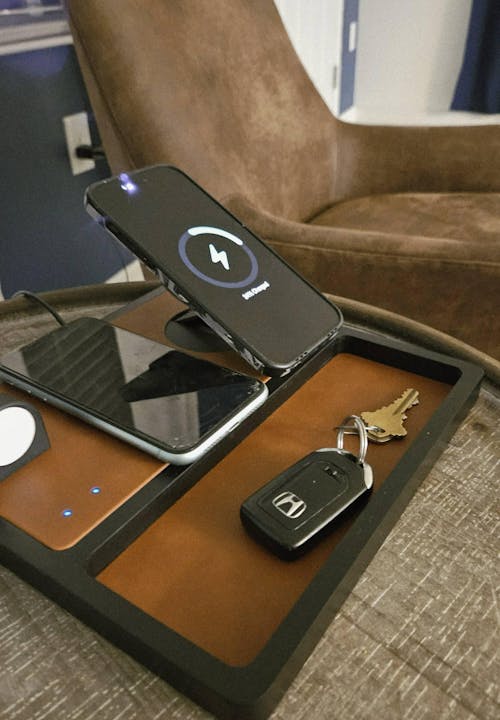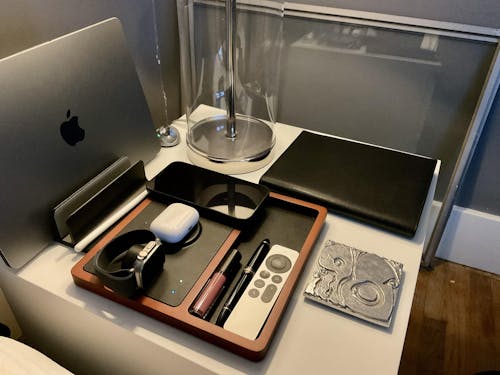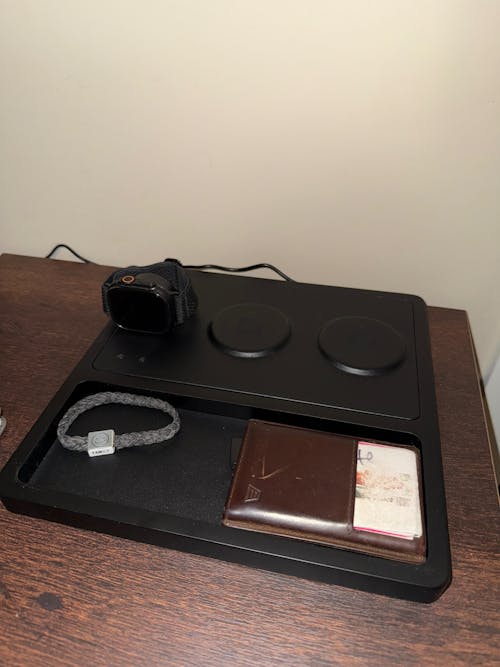- Charges up to 4 devices at the same time
- Single cord solution
- Qi-compatible wireless charging
- MagSafe compatible
- Built in Apple watch and USB-C charging cord
As Featured On:
The only 4-in-1 charging station that allows you to charge four devices at the same time
Before
After
WELCOME NYTSTND
Hi, I'm Adam, the CEO of NYTSTND. With 25 years of experience as a radio technician, I’ve always been passionate about electrotechnology. Over the years, I've designed a magnetic coil that ensures fast and safe charging.
Each of our products are crafted from A-grade leather and birch wood. This commitment to quality materials makes NYTSTND products eco-friendly and non-toxic, as well as distinctly safe and reliable in the market.

Let customers speak for us
Choose your perfect match!
See what’s inside
Join the community!
FAQ's
Wireless chargers are convenient and cable-free solutions for powering up your devices. Follow these simple steps to enjoy the benefits of hassle-free charging.
Step 1: Check Compatibility
First, ensure that your device is compatible with inductive charging technology. Most modern smartphones, smartwatches, and other gadgets are compatible, but it's always good to verify. Look for the "Qi" logo on your device or consult the manufacturer's documentation to confirm compatibility.
Step 2: Choose the Right Product
Select a high-quality bedside charging station that matches your device's power requirements. Some chargers offer fast-charging capabilities, so choose one that suits your needs. Additionally, consider the product's design and size, making sure it accommodates your device comfortably. Avoid using counterfeit or uncertified products, as they may damage your device or pose safety risks.
Step 3: Prepare the Cordless Charger
Connect the supplied power adapter to the charging pad. Use only the provided cable and adapter or a certified replacement to avoid issues. Place the charger on a flat, stable surface, ensuring proper ventilation to prevent overheating.
Step 4: Prepare Your Device
Remove any metallic or magnetic accessories, such as cases or credit cards, from your device, as they might interfere with your family charging station. Some devices require you to enable wireless charging in the settings menu. Make sure your device is clean and free from debris, as foreign particles may obstruct the charging process.
Step 5: Position Your Device on the Charger
Align your device's charging coil with the charger's coil for efficient charging. Most multi-charging stations have a charging indicator light that confirms proper alignment. For optimal results, center your device on the charger. Some chargers support charging in both portrait and landscape orientations, so choose the one that best suits your needs.
Step 6: Charging and Removal
Once your device is correctly positioned, the charging process will begin automatically. The charging indicator light may change color or pulse to indicate charging status. You can still use your device while charging, although it may charge slower than when idle.
When you're done charging, simply lift your device off the charger. There's no need to unplug any cables, making this technology incredibly convenient.
Using a nightstand charging station is a straightforward process that brings convenience to your daily routine. Embrace the cable-free future of charging and enjoy the simplicity and convenience it offers.
Wireless charging, also known as inductive charging, is a technology that allows devices to charge without the need for physical cables. It works based on the principle of electromagnetic induction, converting electrical energy into a magnetic field and then back into electrical energy. Here's a detailed explanation:
- Inductive Charging Technology:
Cordless chargers consist of two main components: a charging pad (or base station) and a receiver in the device to be charged. The charging pad generates an alternating current (AC) which creates a changing magnetic field around it. - Coil in Charging Pad:
Inside the charging pad, there is a coil of wire that is used to generate the alternating magnetic field. When an electric current flows through this coil, it produces the changing magnetic field. - Coil in Device:
The device to be charged, such as a smartphone, also contains a coil of wire known as the receiver coil. This coil is typically located close to the device's battery. - Electromagnetic Field Generation:
When the charging pad is plugged into a power source, an AC current flows through its coil, producing a fluctuating magnetic field around it. This magnetic field extends over a short distance (usually a few millimeters) from the charging pad. - Magnetic Field Induction:
When the receiver coil in the device comes into the range of the fluctuating magnetic field generated by the charging pad, it induces a current in the receiver coil through electromagnetic induction. This current generated in the receiver coil is an alternating current. - Current Conversion:
The receiver circuitry in the device converts the alternating current received from the receiver coil into direct current (DC), which is then used to charge the device's battery. - Power Transfer Efficiency:
It's important to note that inductive charging technology is not 100% efficient. Some energy is lost as heat during the charging process due to factors like distance between coils, alignment, and electrical resistance. - Charging Completes:
As the device's battery charges, the charging circuitry inside the device monitors the battery's state and regulates the charging process to prevent overcharging.
Benefits:
- Convenience: Users can simply place their devices on the charging pad without dealing with cables.
- Wear and Tear Reduction: This technology reduces wear and tear on charging ports since there is no constant plugging and unplugging of cables.
- Flexibility: You can charge multiple devices with different connector types as long as they support wireless charging.
Cordless chargers work by utilizing electromagnetic induction to transfer electrical energy from the charging pad to the receiver coil in the device. As this technology continues to improve, we can expect more devices to support wireless charging, further simplifying our charging routines.
With NYTSTND wireless charger have multiple charging areas, allowing you to place and charge several devices simultaneously without using cables.
Yes, they are are generally good for phones and can be a convenient and practical way to charge your device. Here are some of the benefits and considerations of using wireless chargers for phones:
Advantages of cordless charger for Phones:
- Convenience: Cable-free charging eliminates the need for physical cables, making it easy and convenient to charge your phone. You can simply place your device on the charging pad without dealing with plugging and unplugging cables, which can be especially useful when charging your phone at night or on your desk.
- Wear and Tear Reduction: Frequent plugging and unplugging of charging cables can lead to wear and tear on your phone's charging port. With inductive charging, you can reduce the risk of damaging the charging port over time.
- Versatility: Many modern smartphones support Electromagnetic charging, which means you can use the same inductive charger charger for multiple devices, such as smartphones, smartwatches, and cordless earbuds, as long as they support the Qi wireless charging standard.
- Neat and Tidy: Wireless chargers can help reduce cable clutter and create a more organized charging setup.




























